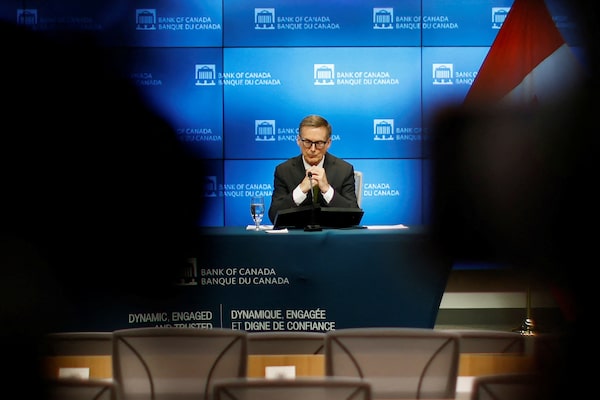
Bank of Canada Governor Tiff Macklem takes part in a news conference after announcing an interest rate decision in Ottawa, Ontario, Canada March 6, 2024. REUTERS/Blair GableBlair Gable/Reuters
Jeremy Kronick is the associate vice-president and director of the Centre on Financial and Monetary Policy at the C.D. Howe Institute, where Steve Ambler, a professor of economics at Université du Québec à Montréal, is the David Dodge Chair in Monetary Policy.
When headline inflation increased to 2.9 per cent in May, up from 2.7 per cent in April, there was much speculation that the Bank of Canada would pause its rate cuts. However, it ticked back down to 2.7 per cent in June. That, plus a weakening labour market and stagnating per capita GDP, made it practically certain the bank would cut on Wednesday. It did.
Whether the bank has entered an easing cycle is no longer the question. The only question left is how far and how fast the Bank of Canada continues to cut interest rates.
There are several upside risks to inflation in the near future which could cause the bank to pause its rate cuts. We think it shouldn’t. Here’s why.
The first upside risk comes from volatility in the shorter-term inflation numbers. This is owing to certain components of the consumer price index. For example, energy prices in general and especially gasoline prices fluctuate a lot, depending on conditions in the rest of the world, both economic and geopolitical.
A shorter-term indicator – inflation over the last month, or over the last three months – has the advantage of excluding what was happening to inflation more than six months ago – which the year-over-year measures the bank targets cannot. Therefore, it can sometimes give a better indication of where inflation is headed in the near to medium term. Unfortunately, these numbers can vary quite a bit from month to month.
Overall CPI inflation throughout the last month was under 1 per cent (all inflation numbers reported here are in annualized terms), which is encouraging, but was above 3 per cent in both March and May, after having fallen below zero in the first month of this year.
Even core inflation, which excludes the more volatile components of inflation, has moved a lot from month to month. CPI-median and CPI-trim inflation – the core numbers followed closely by the bank – were high, with both coming in at 2.9 per cent in June, and over 4 per cent in May.
This is where longer-term trends matter. The six-month rates can move us away from where things were more than six months ago, giving us a more accurate picture of where things stand today, and can also deal with the volatility of month-over-month or three-month inflation measures. And here CPI-trim and CPI-median are clearly on a downward trend, at 2.2 and 2.1 per cent, respectively, in June. The bank should ignore the short-term swings and focus on the trend.
The second upside risk comes from some components of the CPI which have shown persistently high inflation. One of the most important of these is shelter. Shelter inflation was above 6 per cent over the last 12 months, and 3.7 per cent over the last month.
Two components have driven this high inflation – rent and mortgage interest costs. Rent is driven by structural factors such as immigration and barriers to supply, such as zoning restrictions, that are out of the bank’s control. Mortgage interest costs, on the other hand, have been driven by the bank’s own interest rate hikes over the last two years that will, eventually, fall out of the calculation. Without mortgage interest costs, inflation is 1.9 per cent, right at target.
Finally, there are substantial upside risks to inflation stemming from geopolitics. The most notable of these is the possibility of a change in government in the United States after the November election. This comes with the threat of a renegotiation of the Canada-United States-Mexico trade agreement and a push for deglobalization. Tariffs by the U.S., and retaliatory tariffs imposed by Canada and/or other countries from which we import, would increase inflation.
Such an increase would be temporary as prices would shift to a higher level, and then inflation would continue as before but on a higher price path. The Bank of Canada can do nothing about this kind of inflation, short of a monetary policy restrictive enough to push prices down in order to compensate for the one-time impact of the tariffs. If it does not want to do this – and it shouldn’t – the bank can use its communication tools with the public to explain why they are looking past this temporary effect.
The bottom line: the Bank of Canada needs to carry on cutting as inflation gradually subsides. Otherwise, in real terms, i.e. after adjusting for inflation, its monetary policy will become gradually more restrictive even if it leaves the overnight rate where it is. This would risk pushing the economy into a recession.